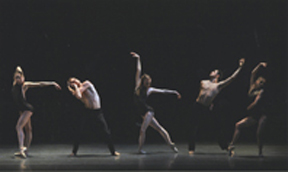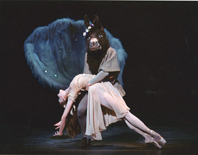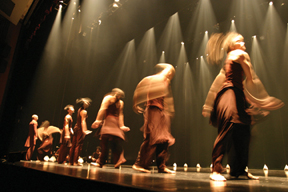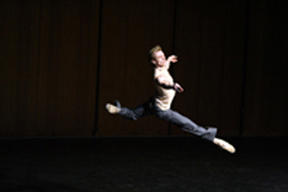New York City Ballet Spring Season
Variety without cohesion
by Leigh Witchel
 It’s cause for rejoicing when a festival of new works produces something that can last beyond the festival. I wouldn’t put money on Mauro Bigonzetti’s ballet “In Vento” (“In the wind” in Italian) persisting in repertory; the score of the same name is another matter. It is composed by Bigonzetti’s frequent collaborator Bruno Moretti and is sonorous, danceable and quite beautiful. Commissioned by NYCB for the Diamond Project and scored for orchestra, the music deftly walks the line between classical and contemporary by seeming not to concern itself with being either traditional or cutting edge. It’s just good work. READ MORE
It’s cause for rejoicing when a festival of new works produces something that can last beyond the festival. I wouldn’t put money on Mauro Bigonzetti’s ballet “In Vento” (“In the wind” in Italian) persisting in repertory; the score of the same name is another matter. It is composed by Bigonzetti’s frequent collaborator Bruno Moretti and is sonorous, danceable and quite beautiful. Commissioned by NYCB for the Diamond Project and scored for orchestra, the music deftly walks the line between classical and contemporary by seeming not to concern itself with being either traditional or cutting edge. It’s just good work. READ MORE
More "Midsummer" Debuts
by Michael Popkin
 The run of George Balanchine’s “A Midsummer Night’s Dream” that opened the Spring at New York City Ballet concluded this week with a flurry of debuts by young dancers. The most newsworthy were the young Andrew Veyette going into the role of Oberon on Tuesday night opposite Sofiane Sylve as Titania, and the even younger Sara Mearns' dancing Titania on Saturday afternoon opposite Joaquin de Luz. Tuesday night’s performance also included eight other debuts: Melissa Barak and Sterling Hyltin as Helena and Hermia; Seth Orza and Amar Ramassar as Lysander and Demetrius; Gwyneth Muller as Hippolyta; Max van der Sterre (still an apprentice) as Theseus; Tiler Peck as the Lead Butterfly; and Robert La Fosse (a retired principal dancer appearing as a guest artist) as Bottom. Besides de Luz as Oberon, the cast behind Mearns on Saturday afternoon was largely that which had danced in the Darci Kistler performances the previous week: Teresa Reichlen as Hippolyta; Rebecca Krohn and Rachel Rutherford as Helena and Hermia, Jason Fowler and Stephen Hanna as Demetrius and Lysander. READ MORE
The run of George Balanchine’s “A Midsummer Night’s Dream” that opened the Spring at New York City Ballet concluded this week with a flurry of debuts by young dancers. The most newsworthy were the young Andrew Veyette going into the role of Oberon on Tuesday night opposite Sofiane Sylve as Titania, and the even younger Sara Mearns' dancing Titania on Saturday afternoon opposite Joaquin de Luz. Tuesday night’s performance also included eight other debuts: Melissa Barak and Sterling Hyltin as Helena and Hermia; Seth Orza and Amar Ramassar as Lysander and Demetrius; Gwyneth Muller as Hippolyta; Max van der Sterre (still an apprentice) as Theseus; Tiler Peck as the Lead Butterfly; and Robert La Fosse (a retired principal dancer appearing as a guest artist) as Bottom. Besides de Luz as Oberon, the cast behind Mearns on Saturday afternoon was largely that which had danced in the Darci Kistler performances the previous week: Teresa Reichlen as Hippolyta; Rebecca Krohn and Rachel Rutherford as Helena and Hermia, Jason Fowler and Stephen Hanna as Demetrius and Lysander. READ MORE
 Akram Khan, born in London to a family of Bangladeshi origin, is that rare fusion artist whose every impulse, in any direction, sings of authenticity. He studied Kathak with Sri Pratap Pawar and became his disciple. He was cast at age 14 by Peter Brook in his “Mahabarata,” in which extraordinary theater work he toured the world between 1987 and 1989. Next he studied contemporary dance, and worked with Anna Teresa de Keersmaeker in Brussels, and began a solo career. He launched his own company in 2000, the year he celebrated his 26th birthday. Quite the resume, no?
And it all comes into play in this work that received its New York premiere, where people either seemed to bounce off it, finding it somehow inhospitable, or fall into its trance. I experienced some of each.
Akram Khan, born in London to a family of Bangladeshi origin, is that rare fusion artist whose every impulse, in any direction, sings of authenticity. He studied Kathak with Sri Pratap Pawar and became his disciple. He was cast at age 14 by Peter Brook in his “Mahabarata,” in which extraordinary theater work he toured the world between 1987 and 1989. Next he studied contemporary dance, and worked with Anna Teresa de Keersmaeker in Brussels, and began a solo career. He launched his own company in 2000, the year he celebrated his 26th birthday. Quite the resume, no?
And it all comes into play in this work that received its New York premiere, where people either seemed to bounce off it, finding it somehow inhospitable, or fall into its trance. I experienced some of each. Berlin has been the site of dance conferences, conclaves and competitions at least since Weimar Republic days in the early 20th Century. This year's Dance Congress Germany turned out not to just national. The official languages were German and English. Presenters and attendees came from around the globe. Held from Thursday evening, April 20 into Sunday afternoon, April 23, in the large, concrete, shell-shaped House of World Culture, it ran with remarkable efficiency and a minimum of fuss considering the many registrants. There were about 1,700 of them! The official slogan or theme of the meeting was "Knowledge in Movement" and scholars as well as dancers tried to "verbalize and embody" concepts that fit under that heading and its 9 subsidiary topics*. Sessions consisted of regular lectures, round tables, demonstrations, dance performances and demonstrations (live and on screen) but also in use were 3 novel formats.
Berlin has been the site of dance conferences, conclaves and competitions at least since Weimar Republic days in the early 20th Century. This year's Dance Congress Germany turned out not to just national. The official languages were German and English. Presenters and attendees came from around the globe. Held from Thursday evening, April 20 into Sunday afternoon, April 23, in the large, concrete, shell-shaped House of World Culture, it ran with remarkable efficiency and a minimum of fuss considering the many registrants. There were about 1,700 of them! The official slogan or theme of the meeting was "Knowledge in Movement" and scholars as well as dancers tried to "verbalize and embody" concepts that fit under that heading and its 9 subsidiary topics*. Sessions consisted of regular lectures, round tables, demonstrations, dance performances and demonstrations (live and on screen) but also in use were 3 novel formats.